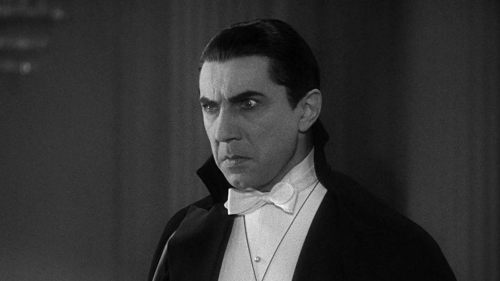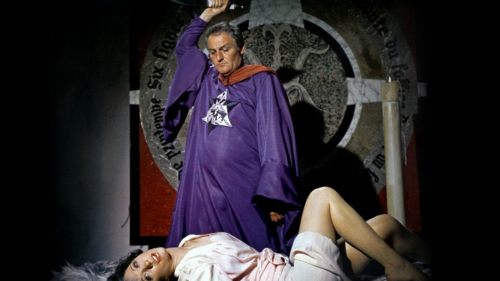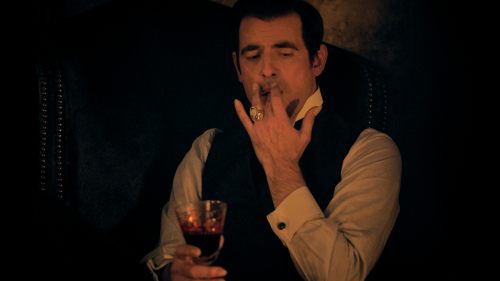The Definitive Dracula: Christopher Lee Is The Greatest Vampire Of Them All
Once upon a time, someone told Christopher Lee that he was too tall to be an actor. That he was too foreign-looking to make it in Hollywood. Two hundred and eighty acting credits, four major franchise appearances (including The Lord of the Rings and Star Wars), and one knighting later, Lee was the one who had the last laugh. Lee was a major player in British military intelligence during World War II, played music in '80s heavy metal band Charlemagne (a band he started), and continued to work in film well into his nineties. Many people throughout his career asked him what he hoped to accomplish as an actor, especially in his role as Dracula, and he has been quoted several times saying that he simply hoped to surprise the audience, to give them something they hadn’t been expecting, especially from his villainous roles. Each moment he was onscreen was mesmerizing; a powerful domineering stance that demanded attention when he sauntered into the room, a flicker of intoxicating cursed madness that glimmered out from behind the eye that captivated and kept its audience under his thrall -- it’s no wonder he was so spectacular at playing the Prince of Darkness.
In 1958 Lee made his debut as the Count in Terence Fisher’s Horror of Dracula, or as it was known in Europe, simply Dracula. Following along fairly closely to Stoker’s 1897 novel, the story told the gothic tale of Jonathan Harker, an innocent man who made his way to the Count’s castle under the false pretense of becoming the Master’s new librarian, but quickly becomes his prisoner instead. Once there, Harker is attacked by one of the women-turned-vampires whom Dracula has sired, and although he is temporarily saved by the man in black, he is soon changed himself as penance for staking and ending the immortal life of the vampire’s dear creation. Eventually, Dracula begins to prey upon Jonathan’s fiancé Lucy, changing both her and her sister-in-law Mina into children of the night, and continues to terrorize the unsuspecting people of this little English town, until finally, one man arrives to put an end to his horrifying crusade – the man with whom he would eventually engage in an eternal skirmish, his arch nemesis, none other than Peter Cushing’s Doctor Van Helsing. This movie perfectly encapsulates the power of a fiery cinematic feud that can occur when two accomplished actors play opposing foes onscreen, while simultaneously also sharing a beloved friendship off-screen. Cushing and Lee became lifelong friends, and their electric chemistry comes through in their performances as they throw themselves into the role of mortal enemies with flash and vigor, marking a clash that would soon become just as memorable as Lee’s dreamy rendition of the seductive serpent.
Eight years later in 1966, it came time for another Hammer Horror Dracula film, but Christopher Lee had already become slightly disenchanted with the Fisher’s illustration of the legendary villain. According to Lee, when he was shown Jimmy Sangster’s script for Dracula: Prince of Darkness, he expressed such contempt for the dialogue that he refused to utter a single word throughout the entire film. To Lee, if the British company refused to use Stoker’s original material from the book, then he didn’t see the point in using any of the words that the screenwriters had created in its absence. However, although Lee only snarled and hissed and didn’t speak any words purely out of spite, his choice to be a strong silent type simply evolved into becoming another well known trait of Dracula’s dark demeanor, with many depictions in the years that followed copying the same quiet display of inner turmoil and outward bloody rampage. Lee may have become disillusioned with the role of Dracula, but it was too late, the spell was already cast on audiences worldwide. The whole globe loved Lee’s casual air of aristocracy, had fallen hard for his titillating terror, and demanded more entries to his wicked story – and they would get it.
In 1968 a new filmmaker sat in the director’s chair as Freddie Francis came on board and unleashed Dracula Has Risen From the Grave upon the world. The film opens with a quiet altar boy going about his usual morning business in the church, and stumbling upon the corpse of a beautiful young maiden dangling upside-down from one of the church bells, her eyes lifeless, and her body drained of blood. The priest tells the Monseigneur that the castle up on the hill is still evil, and the people in town are even afraid to utter the monster’s name. The Monseigneur scoffs and drags the shaking priest up the mountain to go prove to everyone that the beast is dead, once and for all, toting a giant golden cross on his back as he bravely treks up the windy path to the Count’s domain, but along their travels, the petrified priest slips and falls down the mountainside, landing hard upon a frozen patch of water, cracking it open, and accidentally setting Dracula free to ravage the town yet again. This movie is interesting because while there have always been religious themes throughout vampire films, what with Dracula being afraid of crosses and holy water, this is the first one that really relies heavily upon Christianity to act as an opposing force to the vampire’s prowl. The film starts out with its lead character, Paul, admitting to his girlfriend’s family (which happens to include the Monseigneur) that he is an atheist, an act which leaves him promptly removed from the dinner table. There’s always one weakling who becomes Dracula’s minion in every movie, whether it be a crazy person at an asylum nearby, or just a desperate girl who falls under his alluring thrall, but this time, it is surprisingly a man of God, the priest, who starts referring to the monster as Master, and reluctantly runs around to do his bidding. It’s an interesting dynamic, especially because in the end, the one thing that finally smacks Drac down and keeps him in the ground is the hypnotized priest breaking free of his spell and shouting out scripture at Dracula as he lay dying, an act that kills both of them in the process, and finally frees the town from its horrifying ordeal.
Christopher Lee has always been known as a hard worker. He participated in nearly three hundred films, among countless other accomplishments earned during his lifetime, but in the year 1970, Lee was a part of ten different movies, four of which he played his famous role of Dracula. The first of the year was released in April, and it was arguably Lee’s favorite portrayal of the character that he ever did, simply because it was so faithful to Stoker’s vision. Director Jesus Franco shot this non-Hammer Dracula entry, simply titled Count Dracula, which serves as the closest adaptation of the book to date, besides possibly Francis Ford Coppola’s 1992 entry, aptly titled Bram Stoker’s Dracula. Following the story of Jonathan Harker yet again, the young man finds Dracula at his castle, but this time, as an old man who ages backwards, growing younger and younger with each new body that he feeds upon. Although Lee, a stickler for detail, wished that the novel could have been followed even more closely, with the vampire growing literally engorged as he engulfs the blood of the young. Speaking on the subject years later in the cast commentary for Shout Factory’s release of Dracula: Prince of Darkness, Lee seems to look back the most fondly upon this iteration, along with the original 1958 film.
Also within the same year, Lee appeared in the uncredited cameo of Dracula in the off kilter comedy One More Time, directed by Jerry Lewis, as well as making his return to Hammer horror after a brief hiatus with Peter Sasdy’s Taste the Blood of Dracula in June of 1970, and Roy Ward Baker’s Scars of Dracula a few months later in December.
Taste the Blood of Dracula is a rather intriguing entry. Ignoring the non-Hammer Count Dracula, this sequel instead chooses to pick up directly after the events of Dracula Has Risen From the Grave. However, it stands out for more reasons than its somewhat odd notch on Lee’s vampiric timeline. On one hand, it signifies the start of Hammer horror’s racier side, explicitly displaying a woman’s naked breasts for the first time (at least in one of their Dracula films), and also introducing the idea of de-sanctifying a church by hosting a bacchanal in God’s house, and undergoing a satanic ritual to bring the Count back to life. Bored by their tedious lives and searching for adventure, three men foolishly agree to undergo the young Lord Courtley’s demands, purchasing a vial of what is supposedly Dracula’s blood, and participating in Courtley’s plans to bring them all unfathomable power. Of course, once it comes time to drink the blood overflowing from their goblets, the three older men chicken out, leaving Dracula to spend the rest of the movie hunting them down after he is reincarnated into Courtley’s body. This is the first time that a group of commoners willingly cut into their own flesh and engaged in the act of bringing the unholy prince back to life, as opposed to one of his minions killing an innocent and using their blood, or a priest accidentally cracking the corpse out of his casket. This idea became a fairly common premise for the next few movies, most notably in Dracula A.D. 1972 and The Satanic Rites of Dracula in 1973.
Scars of Dracula is probably the goriest Christopher Lee Dracula film ever made. Following a womanizer named Paul (why are there so many Paul’s in these movies?) as he’s on the run from the police and an angry matron’s overprotective father, this is around the time that Dracula actually starts to show some blood on his face after he gets done feeding on one of his victims. It’s also the first time we get to see him climb the exterior castle wall, making him appear more demonic, harder to defeat, and once again giving Lee the chance to set yet another standard for what we know today as typical vampire behavior.
Lee appeared in a few more odd entries throughout the years, such as Pere Portabella’s experimental Cuadecuc, Vampir in 1971, which merely compiled a bunch of stock footage from Jess Franco’s Count Dracula and mixed it with a new soundtrack, and he popped up in Calvin Floyd’s 1975 vampire documentary In Search of Dracula. 1976 marked the last time Lee would ever appear as the Count, as the strange mostly straight comedy Dracula and Son hit theaters, after which Lee, who had been threatening to do so for years, finally called it quits on what arguably became his most well-known cinematic character.
However, before he called it quits for good in 1976, Lee acted in two more Hammer films—Dracula A.D. 1972 in, you guessed it, 1972, and The Satanic Rites of Dracula in 1973. Directed by Alan Gibson, Dracula A.D. 1972 is an odd little melting pot of the old and the new. Although the film begins with a bunch of rebellious ‘70s London youngsters spitting outdated slang, donning bell bottoms, and playing around with black mass and “all that jazz,” it’s also the first Hammer film since Dracula: Prince of Darkness to acknowledge the legendary feud between the sharp-toothed sinner and his mortal enemy Dr. Van Helsing. In fact, once he is summoned by a demented young lad hell-bent on becoming immortal, Dracula’s main goal in the movie is to snuff out the house of Van Helsing forever. It’s a strange dynamic, and although it’s an admittedly pretty goofy entry, it’s still one that’s very much worth watching, especially if you’re curious to see how the series evolved, and Dracula fares in a modern day world.
If you’re heavy into cults and you like a little witchcraft to go along with your bloodsuckers, Alan Gibson’s The Satanic Rites of Dracula is the entry for you. It’s one of the wildest films on the list, stocked to the brim with powerfully mad women performing unholy sermons in the name of their demonic leader, chained lady vampires attacking whatever prey happens to take the wrong turn and stumble unsuspectingly into the basement, and even has a type of secret agency protecting the dark lord and his minions by hunting people down on motorcycle who try to escape their meticulous grasp. It’s a wholly underappreciated gem, as it stands out not only for its warped mysticism, but also because of Dracula’s self-hatred. Usually the Count is hunting down a very specific group of people who have wronged him in some way, whether it be because they tried to kill him or they killed one of his devoted minions, but in this movie, he’s not after a few kids who messed with the wrong vampire – he’s after the entire human race. Dracula seeks to spread a brand new plague that will not only end the world, but himself as well, as it will mean the end of his food supply. Crafting his own personal four horsemen of the apocalypse, Dracula’s reign of terror continues not with his deadly bite, but with an act more belonging to horrific warfare, as he uses sickness as his brand new weapon, all while battling his old foe.
Vampires are cursed beings. Although the idealized notion of staying young forever may sound appealing to the average modern day horror movie fan, make no mistake, these are damned souls, forced to walk the Earth alone for all of eternity. They are forced to turn into horrific monsters and tear apart human flesh and suck down human blood every single day, for the rest of their lives, in order to exist. Each meal must be hunted down. Each prey will cry and fight but must die anyway. It is your duty as a darkened passenger of the undead world. It is your compulsion. You learn to hate who you are, what you represent, and perhaps at some point, the people you hunt down too. You stop pitying them for dying in this moment and start resenting them for what little time on earth they had, because they have the one thing you’ll never attain again – life.
Christopher Lee understood this, and it came through in his performance as Dracula. Lee walked into a room with an air of aristocracy and cast a spell on every soul unfortunate enough to be caught within close proximity of his shadowy presence – the high priest of power and despair. He disbanded the men who challenged him with an effort that seemed like little more than a minor inconvenience, scooped up their petrified women waiting in the wings, and as the proper ladies promptly fainted, used his towering foreboding structure to carry the girls into his chamber like they were nothing more than rag dolls in his arms. His piercing gaze brought fair maidens under his thrall with a mere glance, but once he had them wrapped up in his intoxicating deadly aroma, a certain sadness came over him – almost as if he regretted what he was about to do, but knew he would do it anyway. He was damned to repeat this heinous act forever until the end of time. There are many reasons to love Christopher Lee’s Dracula, but perhaps the strongest and most unexpected of them all is his ability to allow his character to regret his actions – to allow his villain to have layers. There were many portrayals of the Count that came before him, and far more that followed, but no one will ever capture the same deep and profound take on the misunderstood monster quite like Sir Christopher Lee. He will forever and for always reign as the definitive Count Dracula, resting comfortably on his well-earned unholy throne, even long after his mortal soul has left this realm.



